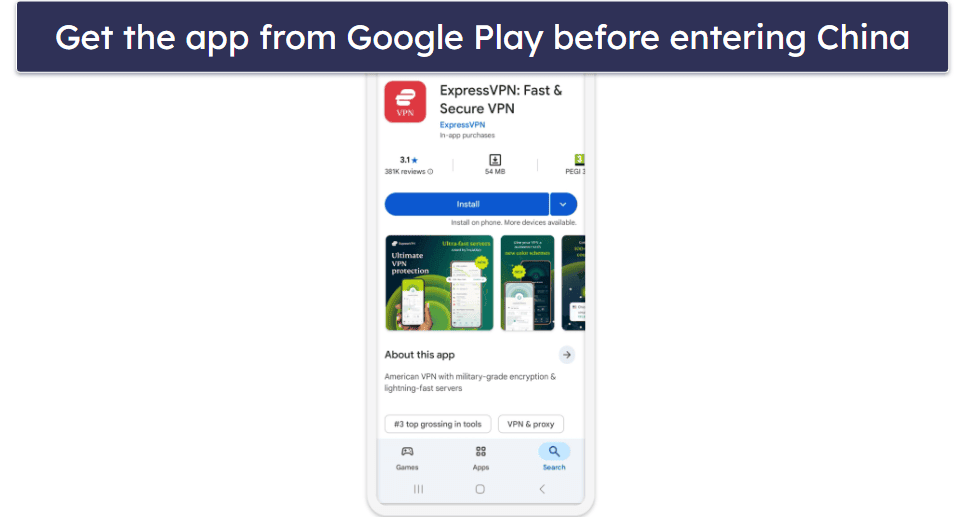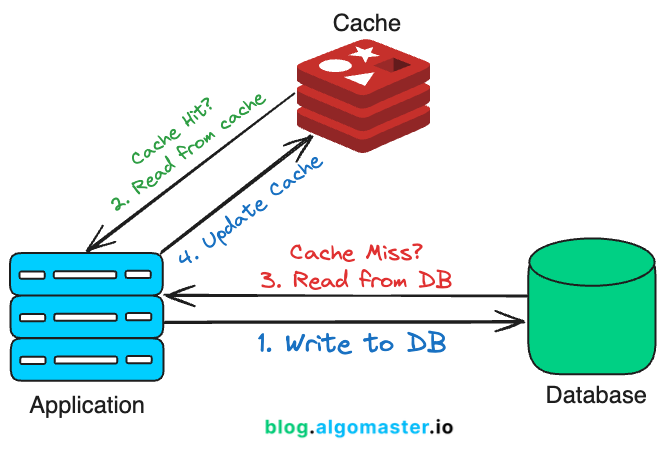Top 5 Caching Strategies Explained
Caching is a powerful technique to reduce latency and improve system performance.
There are several caching strategies, depending on what a system needs – whether the focus is on optimizing for read-heavy workloads, write-heavy operations, or ensuring data consistency.
In this article, we’ll cover the 5 most common caching strategies that frequently come up in system design discussions and widely used in real-world applications.
If you’re finding this newsletter valuable and want to deepen your learning, consider becoming a paid subscriber.
As a paid subscriber, you’ll receive an exclusive deep-dive article every week, access to a structured System Design Resource (100+ topics and interview questions), and other premium perks.
1. Read Through
In the Read Through strategy, the cache acts as an intermediary between the application and the database.
When the application requests data, it first looks in the cache.
If data is available (cache hit), it’s returned to the application.
If the data is not available (cache miss), the cache itself is responsible for fetching the data from the database, storing it, and returning it to the application.

This approach simplifies application logic because the application does not need to handle the logic for fetching and updating the cache.
The cache itself handles both reading from the database and storing the requested data automatically. This minimizes unnecessary data in the cache and ensures that frequently accessed data is readily available.
For cache hits, Read Through provides low-latency data access.
But for cache misses, there is a potential delay while the cache queries the database and stores the data. This can result in higher latency during initial reads.
To prevent the cache from serving stale data, a time-to-live (TTL) can be added to cached entries. TTL automatically expires the data after a specified duration, allowing it to be reloaded from the database when needed.
Read Through caching is best suited for read-heavy applications where data is accessed frequently but updated less often, such as content delivery systems (CDNs), social media feeds, or user profiles.
2. Cache Aside
Cache Aside, also known as “Lazy Loading”, is a strategy where the application code handles the interaction between the cache and the database. The data is loaded into the cache only when needed.
The application first checks the cache for data. If the data exists in cache (cache hit), it’s returned to the application.
If the data isn’t found in cache (cache miss), the application retrieves it from the database (or the primary data store), then loads it into the cache for subsequent requests.

The cache acts as a “sidecar” to the database, and it’s the responsibility of the application to manage when and how data is written to the cache.
To avoid stale data, we can set a time-to-live (TTL) for cached data. Once the TTL expires, the data is automatically removed from the cache.
Cache Aside is perfect for systems where the read-to-write ratio is high, and data updates are infrequent. For example, in an e-commerce website, product data (like prices, descriptions, or stock status) is often read much more frequently than it’s updated.
3. Write Through
In the Write Through strategy, every write operation is executed on both the cache and the database at the same time.
This is a synchronous process, meaning both the cache and the database are updated as part of the same operation, ensuring that there is no delay in data propagation.

This approach ensures that the cache and the database remain synchronized and the read requests from the cache will always return the latest data, avoiding the risk of serving stale data.
In a Write Through caching strategy, cache expiration policies (such as TTL) are generally not necessary. However, if you are concerned about cache memory usage, you can implement a TTL policy to remove infrequently accessed data after a certain time period.
The biggest advantage of Write Through is that it ensures strong data consistency between the cache and the database.
Since the cache always contains the latest data, read operations benefit from low latency because data can be directly retrieved from the cache.
However, write latency can be higher due to the overhead of writing to both the cache and the database.
Write Through is ideal for consistency-critical systems, such as financial applications or online transaction processing systems, where the cache and database must always have the latest data.
4. Write Around
Write Around is a caching strategy where data is written directly to the database, bypassing the cache.
The cache is only updated when the data is requested later during a read operation, at which point the Cache Aside strategy is used to load the data into the cache.
This approach ensures that only frequently accessed data resides in the cache, preventing it from being polluted by data that may not be accessed again soon.
It keeps the cache clean by avoiding unnecessary data that might not be requested after being written.
Writes are relatively faster because they only target the database and don’t incur the overhead of writing to the cache.
TTL can be used to ensure that data does not remain in the cache indefinitely. Once the TTL expires, the data is removed from the cache, forcing the system to retrieve it from the database again if needed.
Write Around caching is best used in write-heavy systems where data is frequently written or updated, but not immediately or frequently read such as logging systems.
5. Write Back
In the Write Back strategy, data is first written to the cache and then asynchronously written to the database at a later time.
This strategy focuses on minimizing write latency by deferring database writes.
This deferred writing means that the cache acts as the primary storage during write operations, while the database is updated periodically in the background.

The key advantage of Write Back is that it significantly reduces write latency, as writes are completed quickly in the cache, and the database updates are delayed or batched.
However, with this approach, there is a risk of data loss if the cache fails before the data has been written to the database.
This can be mitigated by using persistent caching solutions like Redis with AOF (Append Only File), which logs every write operation to disk, ensuring data durability even if the cache crashes.
Write Back doesn’t require invalidation of cache entries, as the cache itself is the source of truth during the write process.
Write Back caching is ideal for write-heavy scenarios where write operations need to be fast and frequent, but immediate consistency with the database is not critical, such as logging systems and social media feeds.
Conclusion
Choosing the right caching strategy depends on your system’s specific requirements.
Here’s a tabular summary:
Thank you for reading!
If you found it valuable, hit a like ❤️ and consider subscribing for more such content every week.
If you have any questions or suggestions, leave a comment.
P.S. If you’re finding this newsletter helpful and want to get even more value, consider becoming a paid subscriber.
As a paid subscriber, you’ll receive an exclusive deep dive every week, access to a comprehensive system design learning resource , and other premium perks.
There are group discounts, gift options, and referral bonuses available.
Checkout my Youtube channel for more in-depth content.
Follow me on LinkedIn, X and Medium to stay updated.
Checkout my GitHub repositories for free interview preparation resources.
I hope you have a lovely day!
See you soon,
Ashish




… [Trackback]
[…] Here you will find 5980 additional Information on that Topic: geeksforgeeks.org/top-5-caching-strategies-explained-3/ […]